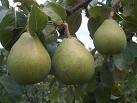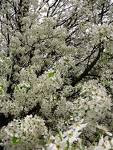It is believed that pears originated in Western Asia and in south-eastern Europe in the Caucasus mountain region. The wild pear was small and hard and gritty, but was probably found by the Neolithic hunter-gatherers. Pears have certainly been around for millennia, and were cultivated in western Asia at least 3,000 years ago. The Himalayan wild pear still grows in the subcontinent and wild pear trees can be found still in Europe.
Homer speaks of pears in his epic poem “The Odyssey” and pears were sacred to the Greek and Roman goddesses Aphrodite or Venus, Hera or Juno and the Roman goddess of the harvest and gardens Pomona. The Romans ate them at the end of their meals along with other fruit such as pomegranates, figs and walnuts, and the Greek Theophrastus (371-286BC) suggests that pear cultivation was common in his day. Pliny, writing later says that Falerian pears were the best for making wine and others were good only when boiled with honey. He didn’t recommend them to be eaten raw. This was the same as later writers in Britain as a 16th century manuscript written by monks in Worcestershire says “Peres causeth ye colyck passion in ye bowelles…” and Gerard the 16th century herbalist suggests that English Perry (a drink like cider which is made from apples) made from pears was good for the stomach as it “comforteth and warmeth” it although it purged people who were not used to drinking it. However he recommends it as being good for digestion. Gerard and his friend Sir Thomas Hanmer were the first in England to propagate pears by grafting them onto quince stock. This was done in France and Belgium at the time, and the practice continues today. Quinces are closely related to pears.
 The Roman historian Tacitus writes that pears were being cultivated at the time of the Roman occupation of Britain, and there were several varieties of pear growing there at that time. In the Domesday Book of 1086, pear trees were mentioned as forming boundaries which illustrates their use as hedges.
The Roman historian Tacitus writes that pears were being cultivated at the time of the Roman occupation of Britain, and there were several varieties of pear growing there at that time. In the Domesday Book of 1086, pear trees were mentioned as forming boundaries which illustrates their use as hedges. Pears are members of the rose family of plants and are also closely related to apples and more distantly to loquats, plums, apricots and peaches. They were taken to America by the colonists and the first pear tree was planted on American soil in 1620. All the pears we have today are believed to come from Pyrus nivalis and Pyrus caucasia, but there are thousands of pear varieties grown around the world.
 Pears have diuretic properties and are useful for expelling stones especially from the kidneys. They are good for cystitis and inflammation of the prostate gland. A tisane can be made from dried pear leaves for these problems. Take 20 grams of dried pear leaves and macerate in ½ litre of boiling water for 20 minutes. And take two cups of this a day one before each main meal. A decoction of the bark (boil 25 grams of the bark in ½ litre of water for 20 minutes) is useful to apply to sprains and bruises, as it will reduce swelling. Pears protect the bladder against cancer, as well as the colon (they are full of fibre) and have astringent qualities so are useful for mild diarrhea and colitis. They have some pain relieving properties, and can help to lower blood pressure. They also promote cardiovascular health, lower cholesterol levels and are good for the eyesight (it’s not just carrots that are good for it.) They are rich in vitamin C and the minerals potassium and copper as well as containing vitamins A, K, E, folate and some of the B-complex ones. They also contain several valuable amino acids, and the minerals manganese, magnesium, phosphorous, chloride, iron, zinc and traces of selenium. They also have potent antioxidant properties, as they contain beta-carotene and ascorbic acid.
Pears have diuretic properties and are useful for expelling stones especially from the kidneys. They are good for cystitis and inflammation of the prostate gland. A tisane can be made from dried pear leaves for these problems. Take 20 grams of dried pear leaves and macerate in ½ litre of boiling water for 20 minutes. And take two cups of this a day one before each main meal. A decoction of the bark (boil 25 grams of the bark in ½ litre of water for 20 minutes) is useful to apply to sprains and bruises, as it will reduce swelling. Pears protect the bladder against cancer, as well as the colon (they are full of fibre) and have astringent qualities so are useful for mild diarrhea and colitis. They have some pain relieving properties, and can help to lower blood pressure. They also promote cardiovascular health, lower cholesterol levels and are good for the eyesight (it’s not just carrots that are good for it.) They are rich in vitamin C and the minerals potassium and copper as well as containing vitamins A, K, E, folate and some of the B-complex ones. They also contain several valuable amino acids, and the minerals manganese, magnesium, phosphorous, chloride, iron, zinc and traces of selenium. They also have potent antioxidant properties, as they contain beta-carotene and ascorbic acid. Until the 18th century pears were not the juicy fruit we have today. These were cultivated from then onwards and the Conference pear was first introduced in Britain at the National British Pear Conference in Hertfordshire in 1885. This pear was awarded the Royal Horticulture Society’s Award of Garden Merit, and is probably the favourite British pear.
Until the 18th century pears were not the juicy fruit we have today. These were cultivated from then onwards and the Conference pear was first introduced in Britain at the National British Pear Conference in Hertfordshire in 1885. This pear was awarded the Royal Horticulture Society’s Award of Garden Merit, and is probably the favourite British pear. Pear trees attract bees because of their nectar, but the trees in Europe are suffering from European Pear Rust. The Royal Horticultural Society and sylva.org. launched a Tree Watch in 2011 and are asking people to adopt a tree or as many as they’d like to and monitor it for signs of this disease.
We all know the meaning of “going pear-shaped”, when a project doesn’t go well this is what we say in English, and clearly this relates to the bottom heaviness of the fruit. However in Pakistan, pears look like russet apples almost round, so this phrase has to be explained. “Apples and pears” are stairs in Cockney rhyming slang too, and of course there is the Christmas carol “The Twelve Days of Christmas” in which “On the first day of Christmas my true love gave to me/ A partridge in a pear tree.” Pears are certainly part of British popular culture.
Ingredients
6 oz Roquefort/creamy Gorgonzola/ goat’s cheese, crumbled
1 head lettuce, torn into bite size pieces
1 avocado, peeled, pitted and diced
⅓ cup walnuts, chopped
3 pears, peeled, cored and chopped
½ cup spring onions sliced finely
Dressing
⅓ cup olive oil
3 tbsps red wine vinegar
1½ tsps sugar
1 clove garlic, chopped
½ tsp salt
1 tsp whole grain mustard (or Dijon)
freshly ground black pepper to taste
Method
Place all the salad ingredients into a bowl and blend the dressing ingredients. Pour the dressing over the salad, toss well and serve.
This has Taste and is a Treat.




